You can also listen to this article in the voice of own Plastic Artist Rosângela Vig:

From your chant the pure grace,
And tenderness I can not;
For with me the sweet lira
Can barely breathe the sounds of love.
When the ropes changed you,
Happy Anacreon 1,
From Meonia 2 the alive source
You drained the clear mood.
The flattering noise
Out of these waters I do not listen,
That moans such as Pluto 3
The rude dweller.
(ALVARENGA, Silva in MASSAUD, 2000, pp. 96,97)
The classical elements that seduced the 19th Century Art, in Europe, also enchanted Brazil. In the poetry of Silva Alvarenga (1749-1814), of Arcadism, the interest for the Antiquity is clear in the references, of the poet, to terms of the period. His poetry paved a way to Romanticism in Brazil, but it was clear the arcade format of his text, for simplicity, for naturalness and for rejection of the Baroque style. While Poetry registered the Arcadism, Brazilian Art changed for the Neoclassic, which remained until around 1870.
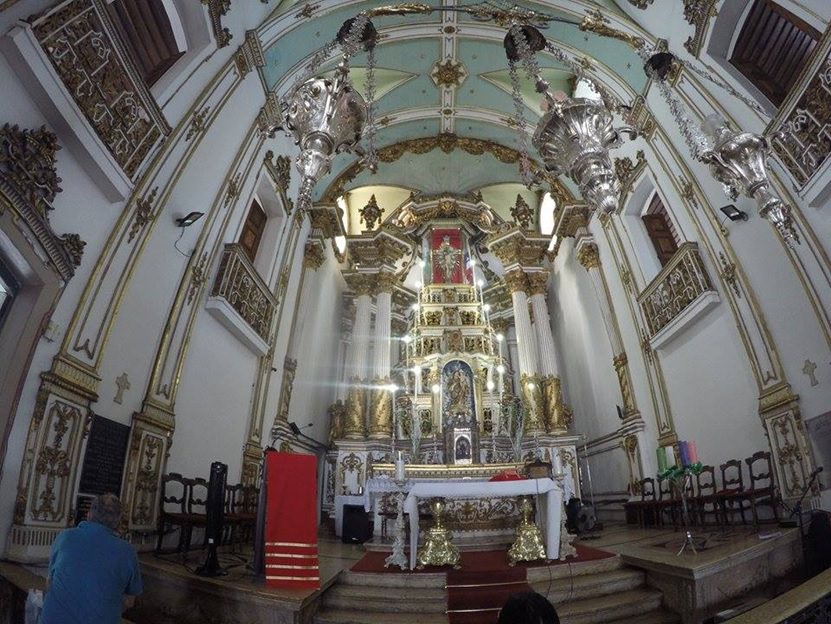
Many changes occurred in Brazil, in 1808 and, one of them was the arrival of the Royal Family. The Rio de Janeiro, where the Court established , became the new cultural and political center of the country. In the artistic field, the innovations of Europe came together with the French Artistic Mission, in 1816, contracted and in charge of directing the Royal School of Arts and Crafts, in Rio de Janeiro. The Group, composed of artists, architects, musicians, mechanics, blacksmiths and carpenters, was led by the writer Joachim Lebreton (1760-1819) and, among the components, were the architect Grandjean de Montigny (1776-1850); The landscaper Nicolas Antoine Taunay (1755-1830) and his brother, the sculptor Auguste-Marie Taunay (1768-1824); The medal engraver Charles-Simon Pradier (1783-1847); and the painter Jean-Baptiste Debret (1768-1848). The group however, encountered obstacles, such as the resistance of the Baroque tradition, already rooted in the country; the scarcity of financial resources and materials; and political intrigues.
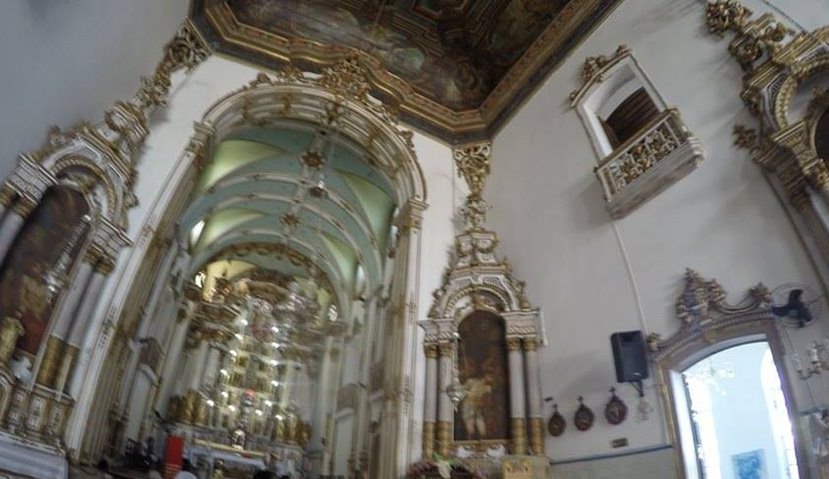
Many of the professions, in Brazil, once passed from person to person, such as Architecture, Sculpture, Painting and Drawing, became officially studied at the School of Arts, known later, as the Imperial Academy of Fine Arts. The site is, currently, the School of Fine Arts of the Federal University of Rio de Janeiro.

Architecture
This is the river, the mountain is this,
These are the trunks, these are the cliffs;
These are still the same groves;
This is the same rough forest.
(COSTA, Cláudio Manuel da in MASSAUD, 2000, pp. 96,97)
Influenced by European models, the Brazilian Art replaced , slowly, the exaggerations of the Baroque, it molded for the academicism and the imitation of the classics. It could not be different in Architecture. The churches came to have a more behaved, less elaborate model, focused on simplicity of form and rationality.

Around here, the Neoclassical left marks in Rio de Janeiro, where the Royal family settled and in several states. And the Architecture of the period came in two ways. There was an official Neoclassical, in the international molds, with a complex level of influence, made with imported material, for the Court, for the official means and for the upper classes. The palaces arose. But there was also, a provincial version of the style, with a more superficial and imitative of the great centers. In shape, as the resources here were still scarce for the complexity of the standard brought from Europe, it was necessary that the materials were brought in from outside. As for the innovations, the external areas began to be valued; were made here, the first planned gardens; the imperial palm tree was used as an element of landscaping. The decoration of the interior spaces was valued, with the coatings, the painting with soft colors, pastel shades and the use of refined objects. The beauty of the Neoclassical served as inspiration for buildings in several states of Brazil.
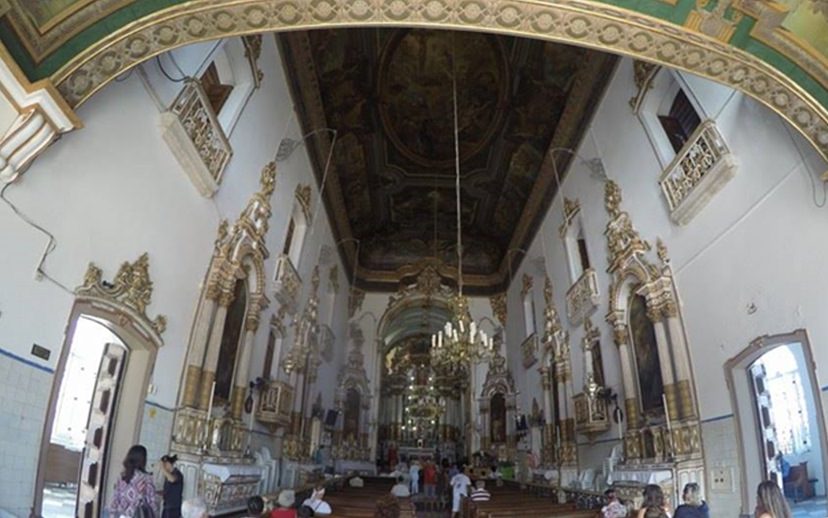
Rio de Janeiro, among the buildings of this style, are the Imperial Palace, the House of the Marquesa de Santos, the Itamaraty Palace, the Catete Palace, the Brazilian National Museum, as well as houses on coffee-enriched farms, which standards were very close to court ones.
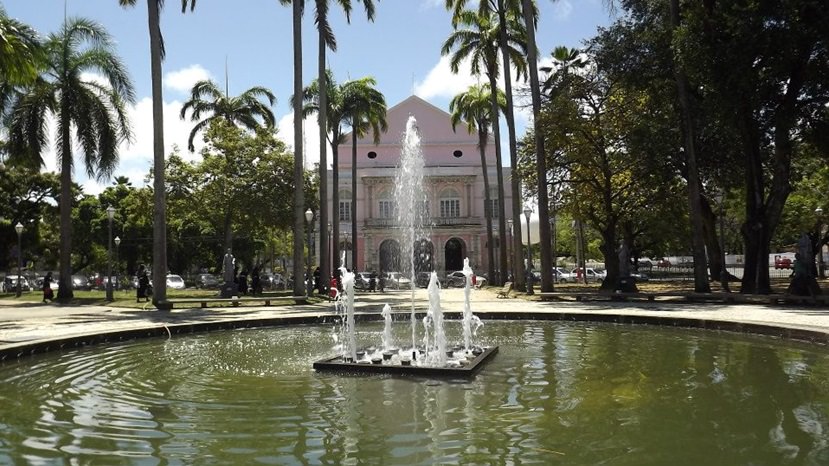
The Imperial Palace, also known as the Imperial Museum 4, was the former summer residence of Dom Pedro I. Its construction, begun in 1845, and it ended only in 1862 and with the participation of leading architects of the Imperial Academy of Fine Arts and a beautiful landscape design. Inside the property, wooden floors imported from various provinces of the empire and there are Carrara marble floors, from Belgium. In the form, the clarity and simplicity are present in the symmetrical facade, with a triangular pediment, reminiscent of classic Italian and Renaissance buildings. On the outer walls, the soft pink tone contrasts with the white lines of the windows. The lower ones have arc-shaped details; the upper ones with rectilinear details.
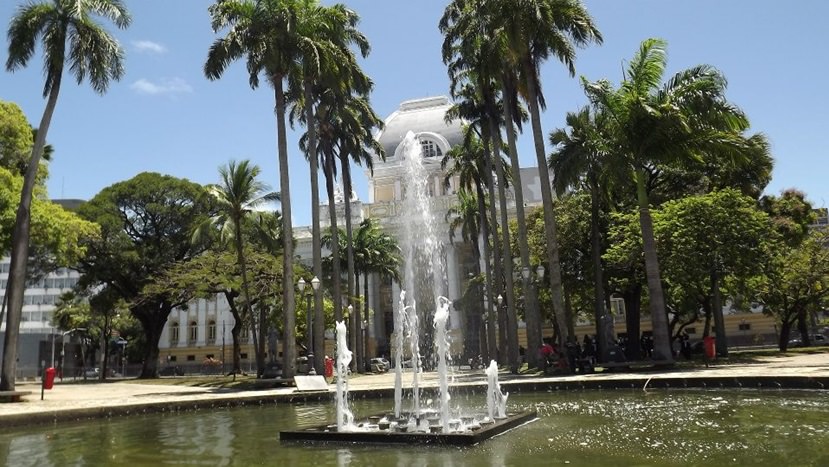
In Bahia, one of the greatest icons of the Christian faith, the Church of Our Lord of Bonfim (Fig. 1), also followed the architectural patterns of period, in its construction and in its interior. Between the beauty of your tile and the frescoes, the building still preserves in its facade, remnants of the Rococo.
Inaugurated in 1850, the Santa Isabel Theater (Fig. 6), in Recife, has already received several celebrities and is one of the most beautiful in the country. Several technological resources have been implemented in its reforms, but the original characteristics that turned it into one of the greatest representatives of the Neoclassical, in Pernambuco remained. Attest the style, the triangular pediment of the facade; the arches and columns in the entrance, aligned with the windows on the upper part; and with the lines and details of the outer walls. For it construction, were imported Italian marble, French iron and Portuguese stones. And Recife guard even as representatives of Neoclassical, the Palace of Justice (Fig. 7) and other public buildings and mansions.
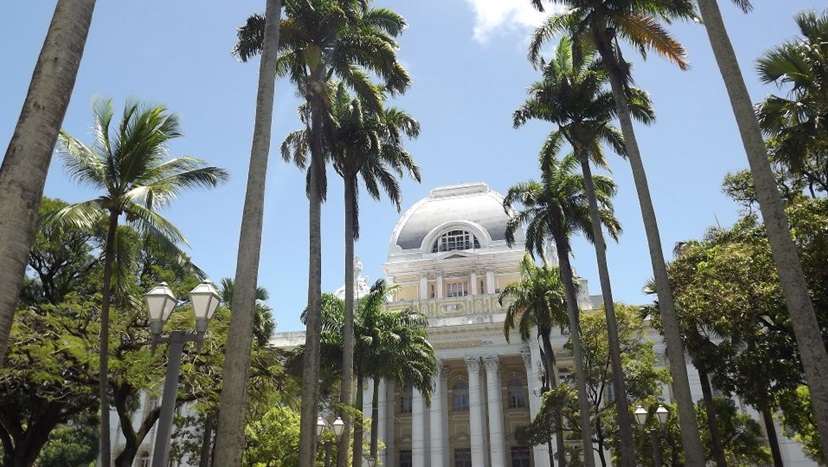
Sculpture
Where, adored Enigma,
Where do you perplexed guide,
Confused and thoughtful
From my idea the faltering course?
What shadows, what portents
Cover my eyes,
The ignored arcane,
That from that distance
You breathe out of your ray as an active effort?
(COSTA, 2014, p.135)
In Imperial Brazil, the arrival of the French Mission made it possible to make official the art teaching. The work of a sculptor, once passed from person to person, now had, an academic methodology. Among the indicated teachers were Auguste-Marie Taunay and Marc Ferrez (1788-1850), later replaced by Francisco Elídio Pânfiro (1823-1852) and Francisco Manuel Chaves Pinheiro (1822-1884).
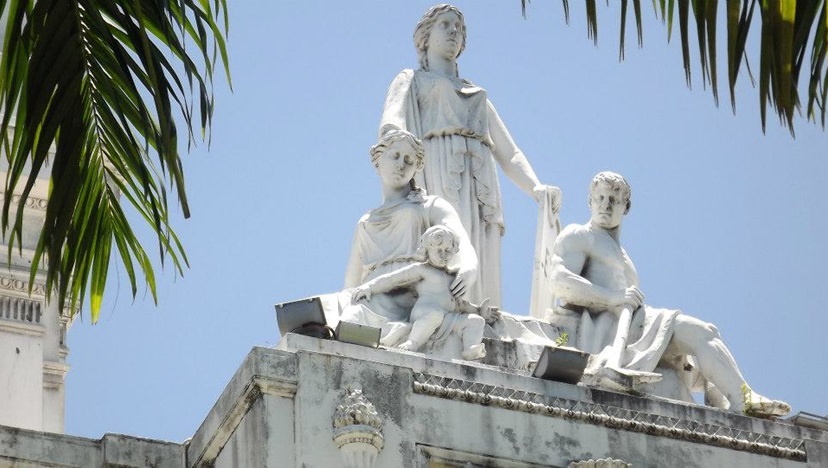
The neoclassical shape can be seen in the work of Chaves Pinheiro 5, the sculptor who produced the most in the second half of the century. The artist studied at the Imperial Academy of Fine Arts, was a pupil of Marc Ferrez and many of his sculptures can be seen in museums, churches and public squares. His dedication to form; his predilection for the study of human figures and the figurative, are clear in his most important work, the Equestrian Sculpture of Dom Pedro II (Fig. 10). With 2,80 meters height and 3 meters length model, the model, made of plaster, was not even cast in bronze, since Dom Pedro II, concerned about his good image in the country, refused the image in favor of building schools. The sculpture, shows Dom Pedro himself on a horse, in military robes, decorated and wearing a hat. His left hand holds the reins of the horse and the right, extended, to salute the people for the victory achieved, n the Surrender of the Uruguayan.
Among the neoclassical characteristics, there is a reference to the events of the time, in the Imperial Brazil. The figure of Dom Pedro, solemn, on his horse, imposing, austere and the power of the emperor transcends. The regularity of form, the harmony of proportion and the correspondence with reality are the same as those of the Antiquity Classics, updated to the neoclassical model, with more significance.
In the Historical Center of Salvador, in Bahia, the Fountain of the Yard of Jesus is related to Mythology. The Sculpture, from 1861, was made of cast iron and it has a circular base, in marble. In the lower part of the image, there are two women and two naked men representing the four most important rivers of Bahia, São Francisco, Jequitinhonha, Pardo and Paraguaçu. Further up, in the other basin of the fountain, as remnants of the Rococo, were carved shells, garlands and dolphins. Further up, there are four girls with their hands interlaced; There is a basin adorned with plants and lastly there is the great image of the Goddess Ceres, representative of Abundance.
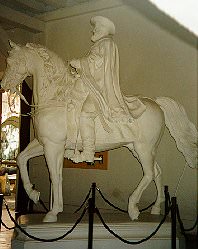
Painting
To dream is to see the invisible forms
From the inaccurate distance and, with sensitive
Movements of hope and will,
It is to search the cold horizon line
The tree, the beach, the flower, the bird, the fountain –
The kisses deserved of the Truth 6.
(PESSOA, 2006, p.68)
The work comes from a dream, in the recesses of the distant soul, drunk itself by what is around. This thought guides the Art and must have led the thinking of many artists in 19th Century in Brazil, because the painting, of that time here, was a pictorial trip in that country where the Portuguese court was settling. And the French artist Jean-Baptiste Debret (1768-1848) was one of the great achievers of this collection, in the shape of Art. In his book, Historical and Pictorial Journey to Brazil, the artist traced and colored the images he saw, from the daily life, from the society of the time, from Indians, slaves, animals and beautiful Brazilian landscapes. His cousin and professor Jacques-Louis David instructed Debret himself (1748-1825), consecrated French artist, of the Neoclassical. Academicism, guided his work and other artists who settled here, in the period, leaving images that narrated an era for the centuries later. In addition to Debret, the French Mission brought Nicolas-Antoine Taunay (1755-1830) and the German Johann Moritz Rugendas (1802-1858). Like Sculpture and Architecture, Painting also began to be officially taught, as the models of the European Neoclassical.
As for Debret, his works photographed the Mid-Nineteenth-Century Brazil, in its daily life. His works went through the Neoclassical and Romanticism, in the approach and for opposing to the Neoclassical rigor, highlighting and valuing national themes. Although instructed to the academic molds, Debret worked freely, without worrying about being a mirror of what he portrayed.
Among the Brazilian artists who attended the Imperial Academy of Fine Arts, are Manuel de Araújo Porto Alegre (1806-1879), who was a pupil of Debret; Victor Meirelles de Lima (1832-1903), who entered the academy at the age of fourteen; and Pedro Américo de Figueiredo e Melo (1843-1905).
Oriented in the academic traditions, Victor Meirelles (1832-1903) transited through Neoclassicism, from which he inherited the balance, the standardization and the rigor of the form; Anatomical clarity and accuracy; And the preference for historical subjects, as in his well-known work, The First Mass in Brazil, from 1860. He adventured also through Romanticism, and added the sentimentality to its style; carried his work of a unique and national identity, dealing with subjects such as Indianism, in Moema.
Academicism is evident in her Study for Marriage of Princess Elizabeth (Fig. 11), one of the works commissioned by the Imperial Family. The artist's preoccupation with the form is present in the image, by the use of proportion, symmetry, the contrasts between light and dark, the richness of detail and the solemn theme. People are gathered for the important event of the nobility, in a richly decorated hall. There are very tall red curtains, very high, with folds and delicate designs at the edges. The walls and floor have delicate designs and the beautiful dresses of the guests have the mold of the period, standing out among them, the emperor and the nobility.
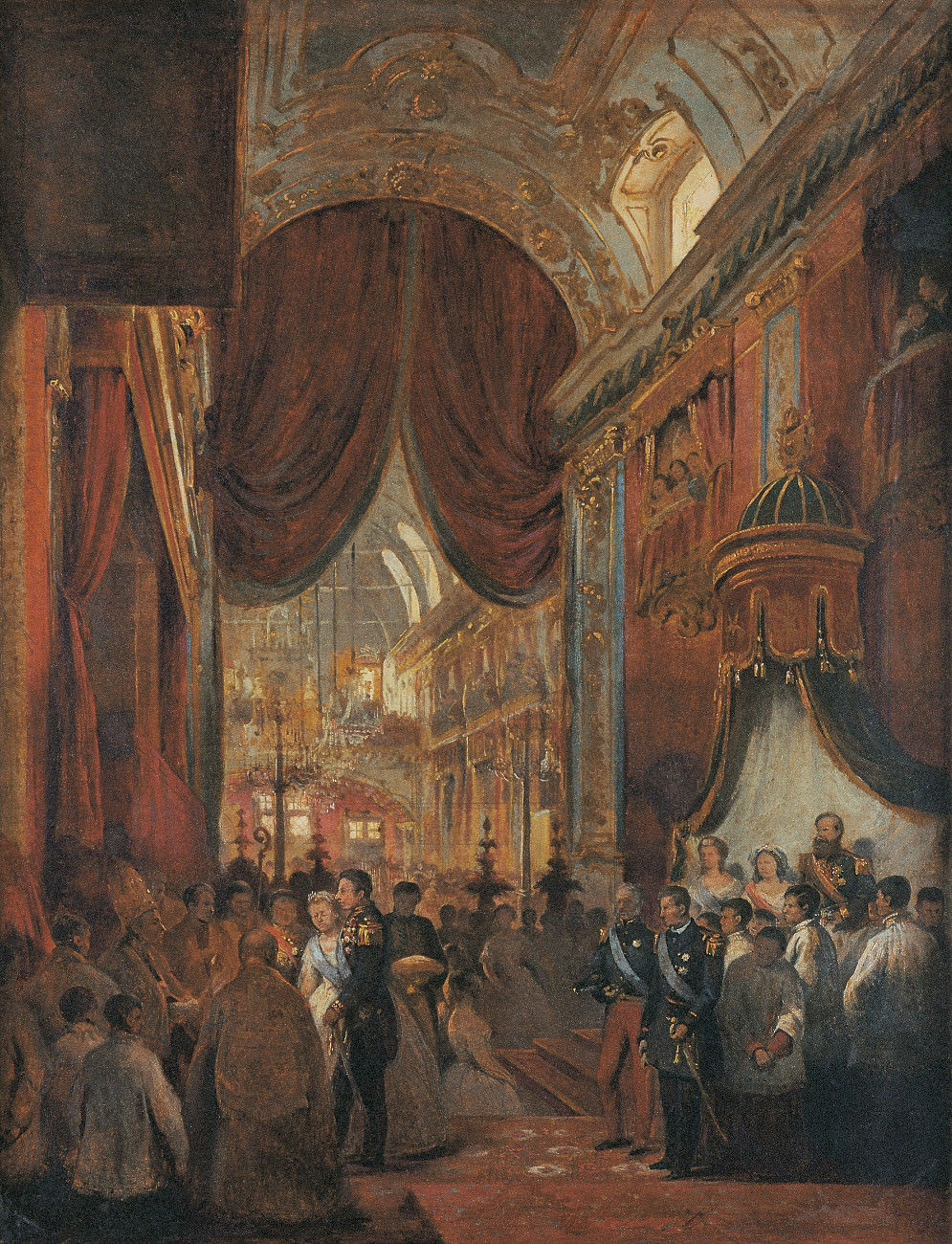
Final Considerations
The artists of the French Mission went beyond the designs assigned to them, to systematize the teaching of the Arts. Inspired by the exuberance of our natural landscapes and by the Brazil still in formation, allowed the creative spirit to act freely. incorporated the European models, to our own, thus disseminating, more than the Art, but also the Culture and History of the country.
The rough stone, the white screen and the beautiful buildings were the testimonies of this creative spirit. The result could be no other than the personalization of a period and a style, which was eventually shaped to our reality.
With the remnants of the Baroque, Rococo and stepping forward to Romanticism, the Neoclassical Brazilian made evident, it witnessed the Culture in transformation and left some of its notch in every little piece of Brazil. The Beauty, here, became a historical record of the way of living of the time and customs.
Always recreate with value
The little or the most you have left.
It continues. In response to the fool
There will always be a scarce flower
Out of the stones and the mud that seek to reach you.
This is your fight.
Your life is erased. Light the fire on the glaciers that surround you.
(CORALINA, 2004, p.244)
1 Anacreon (563 B.C.. – 478 B.C.) was a Greek lyric poet of antiquity. His poetry was much appreciated by the Greek and imitated not only in Antiquity, but also in Byzantine times.
2 Meonia was the original name of the Kingdom of Lydia and came to be a Roman province. The venue, was where today Turkey is located and it was known during the late Antiquity and Middle Ages.
3 In Greek mythology, Pluto was the god of wealth and associated with generosity.
4 Imperial Museum Petrópolis:
www.museuimperial.gov.br
Sign up to receive Event News
and the Universe of Arts first!
5 UNESP Collection:
www.acervodigital.unesp.br/handle/unesp/66511
6 The poet refers to the Truth as a new horizon, a new ocean, after the storm.
…
Liked? [highlight]Leave a comment[/highlight]!
References:
- BAYER, Raymond. História da Estética. Lisboa: Editorial Estampa, 1993. Tradução de José Saramago.
- CHILVERS, Ian; ZACZEK, Iain; WELTON, Jude; BUGLER, Caroline; MACK, Lorrie. História Ilustrada da Arte. São Paulo: Publifolha, 2014.
- CORALINA, Cora. Melhores Poemas. São Paulo: Global Editora, 2004.
- COSTA, Cláudio Manuel da. Poemas Escolhidos. Rio de Janeiro: Editora Saraiva, 2014.
- GOMBRICH, E.H. A História da Arte. Rio de Janeiro: Editora Guanabara, 1988.
- HAUSER, Arnold. História Social da Arte e da Literatura. Martins Fontes, São Paulo, 2003.
- MASSAUD, Moisés. A Literatura Brasileira através dos Textos. São Paulo Ed.Cultrix, 2000.
- PESSOA, Fernando. Mensagem – Obra Poética I. Porto Alegre: Ed. L & PM. 2006.
- POE, Edgar Allan. A Filosofia da Composição. Rio de Janeiro: 7 Letters, 2008. Tradução: Léa Viveiros de Castro.
- SCHILLER, Friedrich Von. A Educação Estética do Homem. São Paulo: Ed. Iluminuras, 2002.
The figures:
Fig. 1 – Church of Nosso Senhor do Bonfim, Salvador, Bahia, Interior in neoclassical style. Photo: Rhea Sylvia Noblat.
Fig. 2 – Church of Nosso Senhor do Bonfim, Salvador, Bahia, Interior in neoclassical style. Photo: Rhea Sylvia Noblat.
Fig. 3 – Church of Nosso Senhor do Bonfim, Salvador, Bahia, Interior in neoclassical style. Photo: Rhea Sylvia Noblat.
Fig. 4 – Church of Nosso Senhor do Bonfim, Salvador, Bahia, Interior in neoclassical style. Photo: Rhea Sylvia Noblat.
Fig. 5 – Church of Nosso Senhor do Bonfim, Salvador, Bahia, Interior in neoclassical style. Photo: Rhea Sylvia Noblat.
Fig. 6 – Teatro de Santa Isabel, Recife, Pernambuco. Photo: Caesar.
Fig. 7 – Palace of Justice, Recife, Pernambuco. Photo: Caesar.
Fig. 8 – Palace of Justice, Recife, Pernambuco. Photo: Caesar.
Fig. 9 – Palace of Justice, Recife, Pernambuco, sculptures. Photo: Caesar.
Fig. 10 – Equestrian sculpture of Dom Pedro II, Francisco Manoel Chaves Pinheiro, 1866. Photo: Museu Histórico Nacional.
Fig. 11 – Study for "wedding of Princess Isabel", Victor Meirelles de Lima, 1864. Photo: Victor Meirelles Museum.
You might also like:
- First Traces of Modern Art – Abstract Expressionism in Brazil by Rosângela Vig
- First Traces of Modern Art – Expressionism in Brazil by Rosângela Vig
- Modern Art – Abstract Expressionism by Rosângela Vig
- First Traces of Modern Art – Impressionism in Brazil by Rosângela Vig
- Modern Art – Surrealism by Rosângela Vig
- Modern Art – Abstractionism by Rosângela Vig
- Modern Art – Cubism by Rosângela Vig
- Modern Art – Expressionism by Rosângela Vig
- First Traces of Modern Art – Symbolism by Rosângela Vig
- First Traces of Modern Art – Post-Impressionism by Rosângela Vig
- First Traces of Modern Art – Impressionism by Rosângela Vig
- Romanticism in Brazil by Rosângela Vig
- Romanticism by Rosângela Vig
- The Rococo in Brazil by Rosângela Vig
- The Neoclassical Art by Rosângela Vig
- Rococo by Rosângela Vig
- How appears the Surreal Work by Rosângela Vig
- The Baroque in Brazil by Rosângela Vig
- Baroque by Rosângela Vig
- Mannerism by Rosângela Vig
- Flemish Art – Renaissance in Northern Europe by Rosângela Vig
- Renaissance by Rosângela Vig
- The Contemporary, A little about the Urban Art by Rosângela Vig
- The Naive Art – Ingénue Art by Rosângela Vig
- Middle Ages, Byzantine Art by Rosângela Vig
- Middle Ages, Romanesque Art and Gothic Art by Rosângela Vig
- The Roman Art by Rosângela Vig
- Greek Art, Art History in Ancient Greece by Rosângela Vig
- The Egyptian Art by Rosângela Vig
- The Prehistoric Art by Rosângela Vig
- The beauty Art and the sublime Art by Rosângela Vig
- The Game of Art by Rosângela Vig
- The Misunderstood Art by Rosângela Vig
ROSÂNGELA VIG
Sorocaba – São Paulo
Facebook Profile | Facebook Fan Page | Website
Columnist at Website Obras de Arte
E-mail: [email protected]

